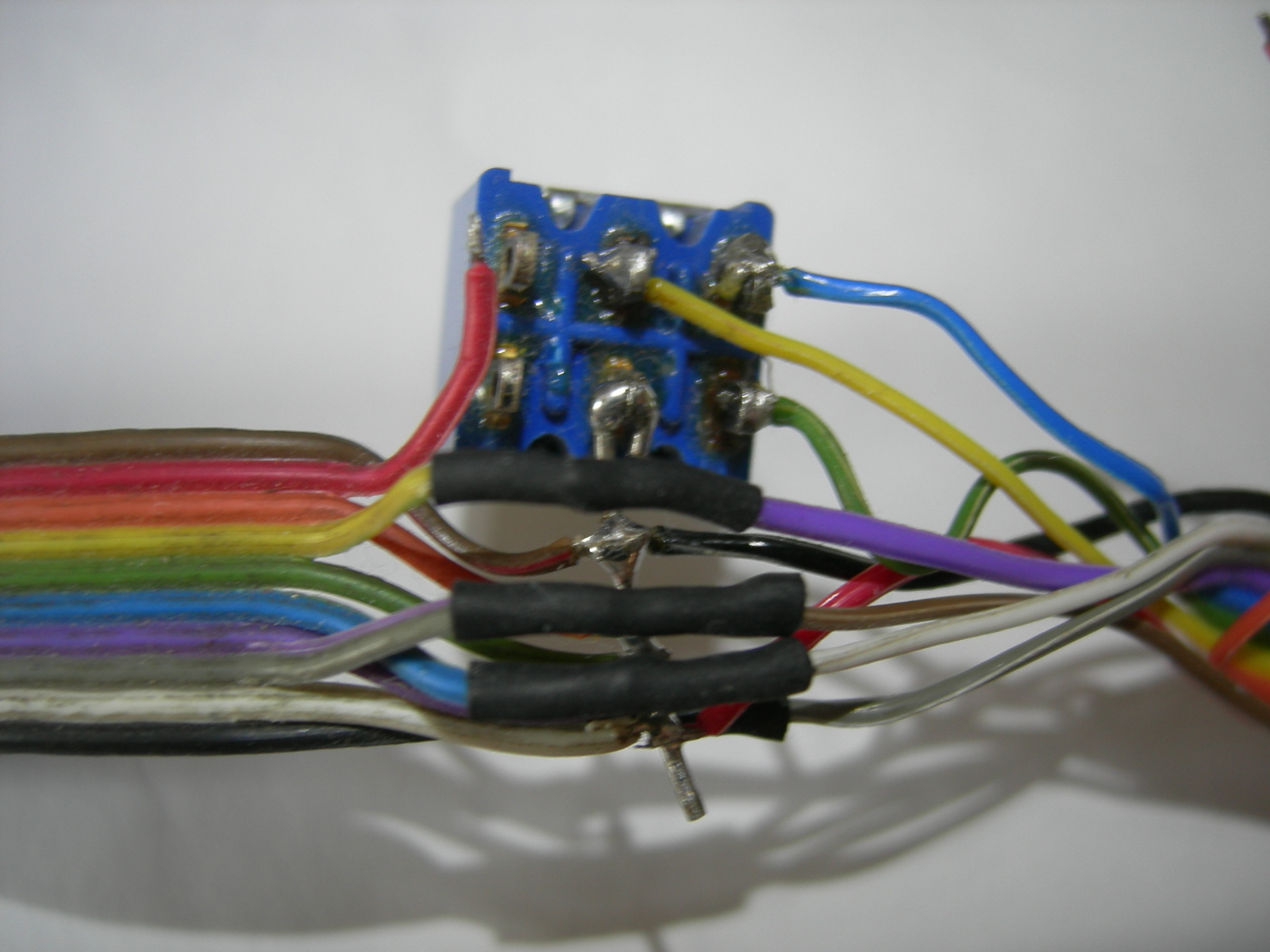Beast_HWV10_Xport1.JPGBeast_HWV10_Xport1.JPGFirmware History:
Note that updates are only provided for the Version 1.0 hardware
currently. Send me a mail in case that you are able to perform the FPGA
update, otherwise it is better that you send me your device back so
that I can update it.
Let me first note that none of the firmware updates until now has neither changed the detection mechanism nor the range.
Revision 1.0 - 13.05.2011
1st production release supporting Mode-A/C and 1bit error correction
Revision 1.1 - 16.05.2011
Correct DF-11 error checking in case that interrogator SI>47.
Who needs this update? All users who live in an area which has radar stations with interrogators SI=48...63. You can check on this Google spreadsheet or simply ask me if I recommend this update
Revision 1.15 - 02.06.2011
Mode-S priority over Mode-AC
Who needs this update?
All users who experience significant drop of Mode-S frame rate when
enabling Mode-AC decoding, which happens at about above 750 Mode-S
frames per second.
Revision 1.21 - 10.06.2011
Baudrate 1MBit replaced by 3MBit - the FPGA now is able to transmit all
incoming data to the FT232 without a bottleneck. With this version I
saw 1300 Mode-S frames and 4500 Mode-AC frames per second in
Planeplotter speed meter.
Who needs this update? All users who still experience a drop of Mode-S frame rate when enabling Mode-AC decoding
Revision 1.30d2 - 24.08.2011
This firmware includes partly the "overlapping frames" decoder. The two
beta testers and I have seen additional 20% Mode-S frames, in one
exception even 39% more frames have been seen.
Some minor improvements in range should be visible as well.
The blue LED is used to indicate FIFO overflow and it flashes whenever
the received data cannot be handled by the output task. Also, it
flashes for heartbeat every 1sec for a short moment. FIFO overflows are
brighter than the heartbeat.
I decided to put this version public because it works stable and I
won't have a chance to publish the complete version for the next weeks.
Expect some more Mode-S frames and an probably equally drastic increase
in Mode-AC.
My maximum frame rate 1804 Mode-S frames per second with two receive channels (screenshot taken too late, but two eyewhitnesses)
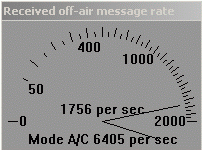
(click on the speedmeter picture to see whole screen)
Note that the USB serial bus is again the bottlneck and the implementation gives Mode-S priority over Mode-AC. |
My maximum distance on the yagi is 300nm:
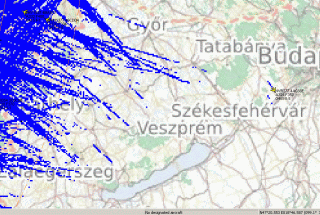
Look at the left side of the picture: There you see the range rings for
200nm (solid) and 225nm (dashed). The 300nm distance of NVR277 is
shown in the bottom line. The picture was taken with prediction off,
so notice that there was a sequence of frames received from this plane
and another one before. Surely there was some good propagation, but at
least those between 200nm and 225nm are regular. |
Downloads: 1CH Firmware V1.30d2 | 2CH Firmware V1.30d2
Who needs this update? All users who have an easy programming capability with USB blasters or similar.
If you do not have an easy programming option? Wait
until the final release V1.30. We then find a solution. The next
series, the one that is currently in production, does have a USB
firmware update capability without external tools, and existing units
can be modified for this feature (maybe only by me, but not for free).
Happy holidays!
Firmware Updates:
I meanwhile decided to release firmware updates, since for anyone who
is really willing to copy the design it is surely easy to read the
serial flash itself. All you then need is a USB blaster or its
compatible derivates, which I meanwhile saw as cheap as USD 13,50 (free
shipping) (Look for "Mini Altera FPGA CPLD USB Blaster programmer
JTAG"). Also, you need to
solder a 10pin connector to the 14pin programming interface (the
remaining 4 pins are those needed for the JTAG).
Pin 1 is next to the small 8 pin serial flash device. Basically nothing can go wrong because this method
can even be used from a point zero. This is the so called "Active Serial" connector.
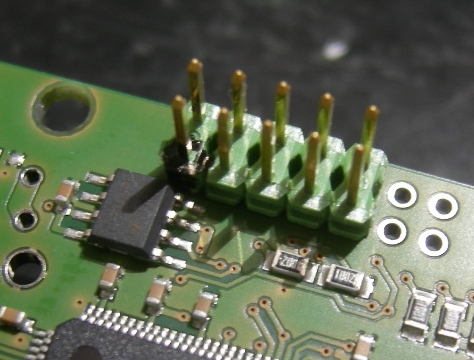
Install Altera Standalone Programmer Version 9.1SP1 (not 11.0, which has prooven to be broken) from this source:
ftp://ftp.altera.com/outgoing/release/91sp1_quartus_programmer.exe
The installation will provide a menu point for the programmer under <Program Files><Altera>
The Mode-S Beast must be connected to USB (or any other +5V power) while programming, the programmer does not supply the unit to be served.
Connect your USB blaster and install it under menu item [Hardware Setup], then select mode [Active Serial Programming],
load the firmware file to be updated with the menu point [Change File...]and select the two check boxes at [Program] and [Verify].
Mini Altera FPGA CPLD USB Blaster programmer JTAG
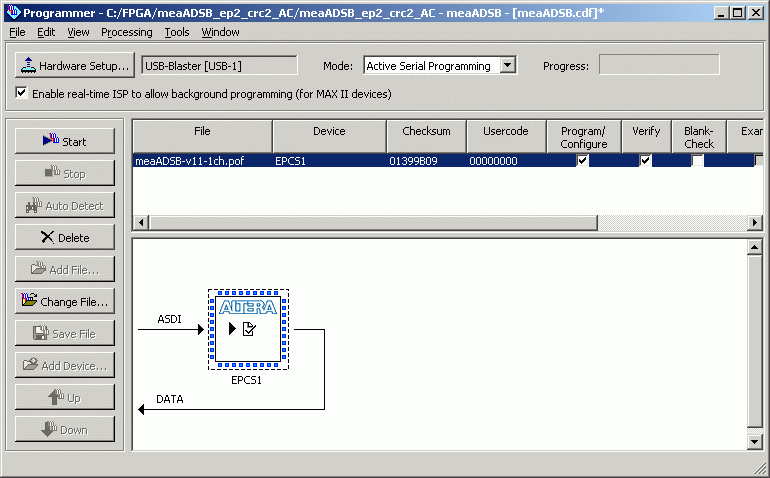
Klick on [|> Start],
after the programming has finished, unplug the cable, when the Mode-S
Beast will immediately return to its normal way of operation.
Hardware Versions:
Currently there are a couple of alpha and beta series units out in the
field, but their owners really know what they have got. For all others,
there is just hardware version V1.0.
HW Version 1.0 - 13.05.2011
1 internal RF channel, Altera Cyclone II EP2C5
HW Version 1.1 - tbd
-
outbreaking feature
- TxD line connected to all serial output devices, no longer a solder jumper
- bigger solder jumpers
- DIP switch for RTS moved to one of the solder jumper (since just very rarely needed after Planeplotter update)
- Lantronix Xport rotated to PCB upside, can easily be monted on
ZIP IC socket (I have thousands, will deliver them with each Xport)
- 1pps input for external MLAT counter synchronisation
Firmware Update with SPI adapter:
It is also possible to update the Mode-S Beast with a SPI flash programmer, like the Blackcat. Support for this will not be given hands-on, you must know what you do.
- connect the 4 lines CLK, DATA, ASDI and nCS to the SPI programmer
- bring nCONFIG to GND
- bring nCE to VCC (3.3V)
Then select a SP25M10 flash device and download the raw binary file, it might be that the bytes are low-high swapped.
Blackcat SPI adapter to Active Serial connector adapter, the switch
disables the FPGA and allows access to the SPI configuration device
